 My last of the 6 site visits in 7 days was to Algoma DSB in Sault Ste. Marie. Approximately 20 people attended their Learning Connections session including: a superintendent, administrators, consultants along with SERTS and math teachers from 4 different schools. A wide variety of people are involved in the project to learn together and to break down the silos of teacher, special education, consultants and administrators. Their main goal is to focus on students in grade 9 applied mathematics by learning about the Cognitive Processes and how they map onto the Mathematical Processes. Their inquiry question is:
My last of the 6 site visits in 7 days was to Algoma DSB in Sault Ste. Marie. Approximately 20 people attended their Learning Connections session including: a superintendent, administrators, consultants along with SERTS and math teachers from 4 different schools. A wide variety of people are involved in the project to learn together and to break down the silos of teacher, special education, consultants and administrators. Their main goal is to focus on students in grade 9 applied mathematics by learning about the Cognitive Processes and how they map onto the Mathematical Processes. Their inquiry question is:
IF we build the capacity of applied level Math teachers to design and deliver Math instruction that effectively embeds the accommodations required for students with Learning Disabilities THEN students with Learning Disabilities in Grade 9 Applied 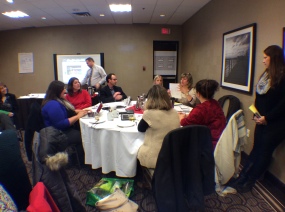 courses will improve their Numeracy achievement.
courses will improve their Numeracy achievement.
This is their second session with the group, so teachers were able to try some of the strategies they learned from the fist session. These are some examples:
- recognized that many students have needs around working memory
- used cue cards for students where they could write down important information
- 3 students continue to use cue cards all the time
- fostering a growth mindset
- tell the student that its ok to write something down that is wrong and then learn from this
- YET is posted on the wall: you may not be their YET, but will get there
- using iPads in the class with Prizmo app
- Prizmo – take a photo of the material and app reads the content which is helping students understand the material better
- going super slow to support students better while addressing the need to be more organized along with improving math skills
- using interactive notebooks: table of contents, words worth knowing and lots of folding paper (Sharon Hagon – blogger about interactive notebooks)
After the sharing, the group moved to look more deeply at the Cognitive Processes: 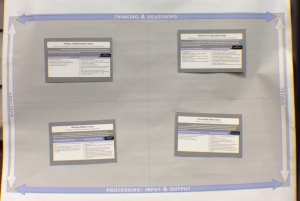
- verbal comprehension
- perceptional reasoning
- memory/working memory
- processing speed
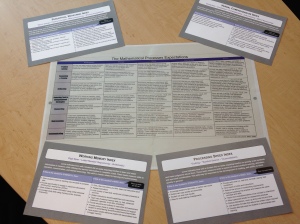 provided a chart that summarized and clearly explained the 7 Mathematical Processes. Now, it was time to combine the two! Using the document on Edugains website “Supporting Students with Learning Disabilities in Mathematics” by the YCDSB, they divided into groups to address the question: How does each of the Cognitive Process needs impact the Mathematical Processes? For example: if a student has the need Processing Speed, how would that impact each of the mathematical processes? WOW! That is what I have to say. This was such an amazing learning experience and a fabulous document to better understand our students with LD in our math classes.
provided a chart that summarized and clearly explained the 7 Mathematical Processes. Now, it was time to combine the two! Using the document on Edugains website “Supporting Students with Learning Disabilities in Mathematics” by the YCDSB, they divided into groups to address the question: How does each of the Cognitive Process needs impact the Mathematical Processes? For example: if a student has the need Processing Speed, how would that impact each of the mathematical processes? WOW! That is what I have to say. This was such an amazing learning experience and a fabulous document to better understand our students with LD in our math classes.The group then reviewed a short lesson on looking for relationships (graphing). The math people looked at how the lesson relates to the 7 Mathematical Processes and the special education group look at the Cognitive Processes. 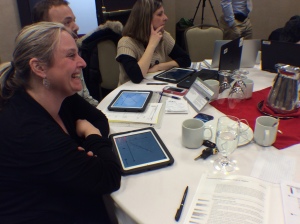 One interesting point that came up during the discussion on this was the special education group commenting on how students with perceptual reasoning deficit may observe a graph on its side so they see it as decreasing not increasing. This then lead to a tech moment (there were a few of these throughout the day):
One interesting point that came up during the discussion on this was the special education group commenting on how students with perceptual reasoning deficit may observe a graph on its side so they see it as decreasing not increasing. This then lead to a tech moment (there were a few of these throughout the day):
- Nearpod: lesson can be shared to each iPad and students can interact with the lesson.
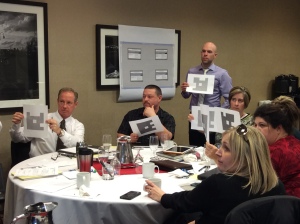
- Poll Everywhere: a tool for classroom clickers.
- Plickers: Classroom polling without the need for devices in the students’ hands (see photo)
- Desmos: awesome tool for teachers and graphing. Can also import photos and do real world examples with sliders on top of photo. Check out the teacher resource site.
- MyScript Calculator: hand write your equations to get results.
- superintendent and administrators were involved in the learning all day and were leading the session
- there was a variety of grouping types throughout the day
- many different activities were included that required movement – which also modelled how you can keep your students moving and learning
- there was lots of discussion by everyone in the room – it was a safe learning environment
My fun pic for the visit is a result of having a  friend from middle school who lives in The Soo. I had the opportunity to visit her and her family for dinner on the day I arrived. So great to have a home cooked meal while travelling and fun to play with her daughter with the cool colouring book I found at the airport 🙂
friend from middle school who lives in The Soo. I had the opportunity to visit her and her family for dinner on the day I arrived. So great to have a home cooked meal while travelling and fun to play with her daughter with the cool colouring book I found at the airport 🙂
Thanks for a wonderful visit everyone!